![]()
![]()
![]()
Use LEFT and RIGHT arrow keys to navigate between flashcards;
Use UP and DOWN arrow keys to flip the card;
H to show hint;
A reads text to speech;
173 Cards in this Set
- Front
- Back
|
What two changes can result in interstitial edema?
|
1) Increased capillary pressure
2) Reduced colloid osmotic pressure |
|
|
What is transudate?
|
Edema fluid as a results of volume or pressure overload, or under conditions of reduced plasma protein.
|
|
|
What is exudate?
|
The result of an inflammatory edema due to increased vascular permeability.
|
|
|
Increased hydrostatic pressure as a cause of edema:
|
1) localized increases in pressure can result from impaired venous return
2) generalized increases in venous presure occur most in CHF. Reduced renal perfusion makes the problem worse by upping aldosterone and volume retention --> even more fluid for the failing heart to deal with --> generalized edema. |
|
|
Reduced plasma osmotic pressure as a cause of edema:
|
Albumin is the protein responsible for maintaing osmotic pressure. Albumin loss can occur with nephrotic syndrome, liver disease or protein malnutrition.
Renal hypoperfusion leads to high aldosterone and salt retention; but these cannot correct the problem --> makes the edema worse. |
|
|
Lymphatic obstruction as a cause of edema:
|
Impaired lymphatic drainage and consequent lymphedema are usually localized; can result from inflammation or neoplastic obstruction.
|
|
|
Sodium and water retention as a cause of edema:
|
Increased salt with the obligate retention of water causes both increased hydrostatic pressure and reduced vascular osmotic pressure.
Salt retention can occur with any compromise of renal function, as in poststreptococcal glomerulonephritis or acute renal failure. |
|
|
Summary of the causes of edema:
|
1) increased hydrostatic pressure caused by a reduction in venous return
2) Decreased colloid osmotic pressure, due to reduced albumin 3) Lymphatic obstruction 4) Primary renal sodium retention 5) Increased vascular permeability |
|
|
Pulmonary edema:
|
A common problem seen with left ventricular failure, but it also occurs in renal failure, ARDS, pulmonary infections and hypersensitivity reactions.
The lungs typically weight 2-3 x than normal, and contain a frothy blood tinged fluid containing some red cells. |
|
|
Acute pulmonary and hepatic congestion:
|
1) Congestion is a passive process resulting from impaired venous return out of a tissue.
2) Acute pulmonary congestion is characterized by alveolar capillaries engorged with blood . 3) In acute hepatic congestion the central vein a sinusoids are distended with blood --> liver hypoxia --> fatty change |
|
|
Chronic pulmonary and hepatic congestion:
|
1) Chronic pulmonary congestion is characterized by alveolar spaces containing numerous hemosiderin-laden macrophages (heart failure cells).
2) In chronic hepatic congestion you get "nutmeg" liver |
|
|
General characteristics of shock:
|
1) Shock is the final common pathway for severe hemorrhage, extensive trauma or burns, large MI, massive pulmonary embolism and microbial sepsis.
2) Shock gives rise to systemic hypoperfusion; it can be caused either by reduced cardiac output or by reduced effective circulating volume. The end results are hypotension, impaired tissue perfusion and cellular hypoxia. |
|
|
Five types of shock:
|
1) Cardiogenic shock resulting from failure of the cardiac pump.
2) Hypovolemic shock resulting from loss of blood or plasma volume 3) Septic shock caused by microbial infection 4) Neurogenic shock as a result of anesthetic accident or spinal cord injury 5) Anaphylactic shock caused by an IgE hpersensitivity reaction. |
|
|
What kind of bacteria cause most cases of septic shock?
|
Endotoxin-producing gram negative bacilli
- Endotoxins are bacterial wall LPS |
|
|
What cellular effects does LPS have on immune cells and endothelial cells?
|
- LPS attaches to a circulating LPS binding protein which then binds to the CD14 receptor on monocytes, macrophages and neutrophils
- Activation of CD14 results in activation of mononuclear cells and production of cytokines IL-1 and TNF - These cytokines act on endothelial cells to reduce synthesis of anticoagulation factors such as tissue factor pathway inhibitor and thrombomodulin. |
|
|
The effects of LPS on the immune system and vasculature are dose dependant:
|
1) At low doses, LPS activates monocytes, macrophages and neutrophils; activates compliment - leading to local eradication of bacteria.
TNF and IL-1 induce endothelial cells to express adhesion molecules. These responses enhance LOCAL acute inflammatory responses and clearance of the infection. 2) With a moderate level of LPS, endothelium express NO and platelet activating factor. In addition, systemic effects of TNF and IL-1 induce fever, increased acute-phase reactants and increased production of neutrophils. The endothelium is tipped toward a procoagulant state. 3) At very high levels, the same cytokine and secondary mediators, now at high levels, result in: Systemic vasodilation Diminished myocardial contractility Widespread endothelial injury and activation, causing systemic leukocyte adhesion and diffuse alveolar capillary damage in the lung. - Activation of the coagulation system, resulting in DIC. |
|
|
Three phases of shock:
|
1) An initial nonprogressive stage during which reflex compensatory mechanisms are activated and perfusion of vital organs is maintained.
2) A progressive stage characterized by tissue hypoperfusion and onset of worsening circulatory and metabolic imbalances. 3) An irrerversible stage that sets in after the body has incurred cellular and tissue injury so severe that even if the hemodynamic defects are corrected, survival is not possible |
|
|
Compensatory mechanisms activated in the initial phases of shock:
|
Neurohumoral mechanisms help maintain cardiac output and blood pressure.
These include baroreceptor reflex, activation of RAA, antidiuretic hormone release and sympathetic stimulation. The net effect is tachycardia, peripheral vasoconstriction and renal conservation of fluid. |
|
|
Mechanisms activated during the progressive stage of shock:
|
- Tissue hypoxia becomes widespread. Anaerobic glycolysis produces excessive lactic acid.
Metabolic acidosis lowers the tissue pH and blunts the vasomotor response; arterioles dilate and blood pools in the microcirculation. |
|
|
Characteristics of irreversible stage shock:
|
- Widespread cell injury results in lysosomal leakage further aggravating the shock state.
- Myocardial contractile function worsens, in part due to NO synthesis. - Ischemic bowels may allow intestinal flora to enter the circulation, worsening endotoxic shock. - Patient has renal shutdown due to ischemic tubular necrosis. |
|
|
Cellular and tissue changes in shock:
|
- Fibrin thrombi in kidney glomeruli
- Adrenal gland lipid depletion - Acute tubular necrosis in the kidneys - GI tract may manifest focal mucosal hemorrhages and necrosis - Lung alveolar damage may occur in bacterial sepsis |
|
|
Diagram of the effects of varying levels of LPS:
|
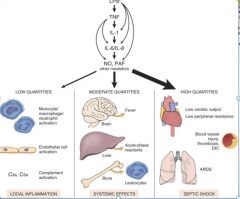
|
|
|
Diagram of hypovolemic shock effects:
|
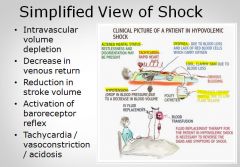
|
|
|
The cytokine cascade in sepsis:
|
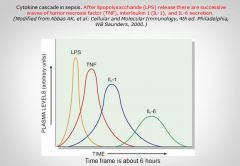
|
|
|
Effects of cytokines/LPS on the permeability of vessels:
|
- Permeability:
Fluid seeps through the endothelium via open pores creating edema and reducing available intravascular volume - Vasodilation: LPS has direct effect on iNOS in endothelium which leads ot local ↑NO and, through cGMP causes vasodilation |
|
|
Metabolic disturbances during sepsis:
|
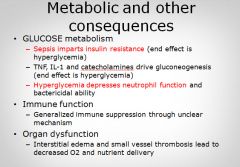
Hyperglycemia will temporarily increase urine output; until fluids are depleted.
|
|
|
What is the management for septic shock?
|
- Antibiotics
- Insulin for hyperglycemia - Fluids to reinstate intravascular volume and replace interstitial losses - Correction of adrenal insufficiency is often required; corticosteroids may be needed |
|
|
What is the relationship between lactate levels and survival in shock?
|
- Normal levels of lactate are between 0-4.
- The higher the level of lactate, the worse the outcome |
|
|
The role of the interstitial space in shock:
|
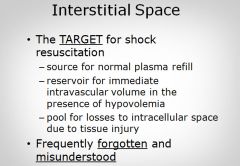
|
|
|
Treatment of cardiogenic shock:
|
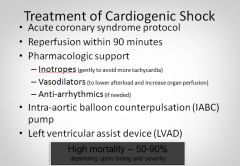
|
|
|
Key points 1 from the shock lecture:
|
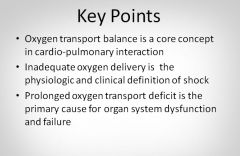
|
|
|
Key points 2 from the shock lecture:
|
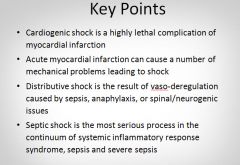
|
|
|
Lipid Levels:
|
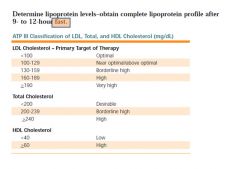
|
|
|
What is the calculation for determining LDL?
|
Total cholesterol = HDL + LDL + TG/5
|
|
|
Risk factors for coronary heart disease:
|
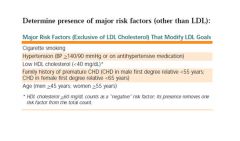
|
|
|
LDL level goals correlated with risk factors:
|
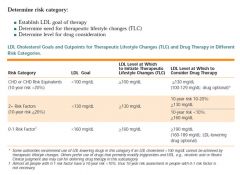
Drug of choice to prescribe is a statin!
|
|
|
Order of therapy goals for dyslipidemia:
|
- Treat TG over 500 first to prevent pancreatitis
- Then treat LDL to goal level - Then treat HDL to goal level |
|
|
What is the recommended age to start screening for lipids?
|
Recommended age to start screening for high cholesterol/LDL is at age 20! Should screen every 5 years.
|
|
|
Current guidelines for the use of aspirin:
|

|
|
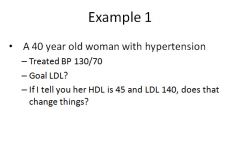
|
Goal is 160; she is at 140 so she does not need any treatment.
|
|
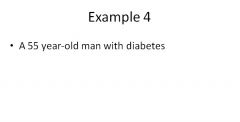
|
Three risk factors (diabetes counts as two?)
LDL goal of 100 |
|
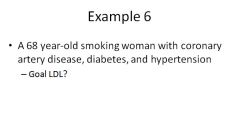
|
Multiple risk factors
LDL goal is less than 70 |
|
|
What is a serious side effect of an extremely low cholesterol level?
|
Violence; cholesterol is necessary for cell membranes and nerve myelination.
|
|
|
What is the definition of cardiac failure?
|
The inability of the heart to pump blood forward at a sufficient rate to meet the metabolic demands of the body (forward-failure)
OR The ability to do so only if the cardiac filling pressures are abnormally high (backward failure) OR BOTH |
|
|
What is the effect of stretching on heart muscle fibers?
|
Stretching the muscle before stimulation optimizes the overlap and interaction of myosin and actin filaments, increasing the number of cross bridges and the force of contraction.
Stretching cardiac muscle fibers also increases the sensitivity of the myofilaments to calcium, which further augments force development. |
|
|
What is the Frank-Starling relationship?
|
Ventricular output increases in relation to the preload.
(The larger the ventricular volume during diastole, the more fibers are stretched before stimulation and the greater the force of the next contraction) |
|
|
What is cardiac output equal to?
|
Stroke volume x Heart rate
The three major determinants of stroke volume are preload, afterload and myocardial contractility. |
|
|
What is the equation for stroke volume?
|
End diastolic volume - End systolic volume
|
|
|
What is the equation for ejection fraction?
|
EF = stroke volume / end diastolic volume
Normal range is 55-75% |
|
|
What is Compliance?
|
Intrinsic property of a chamber that describes its pressure-volume relationship during filling. Reflects the ease or difficulty with which the chamber can be filled.
Compliance = Change in volume/change in pressure |
|
|
Random observation:
|
So if CO = HR x SV and stroke volume is determined by preload, afterload and contractility....
A decrease in preload will result in a lower CO and vice-versa. A decrease in contractility will also result in a lower CO. An increase in afterload will result in a lower CO. |
|
|
Afterload:
|
Afterload is equal to P x r / 2h
P=ventricular pressure r = ventricular chamber radius h = ventricular wall thickness So... An increase in ventricular pressure or chamber radius will increase wall stress/afterload. AND An increase in ventricular wall thickness will decrease wall stress/afterload. |
|
|
Contractility:
|
When contractility is enhanced pharmalogically, the ventricular performance curve is displaced upward such that at any given preload, the stroke volume is increased.
Conversely, when a drug that reduces contractility is administered or the ventricle's contractile function is impaired, the curve shifts in a downward direction, leading to reductions in stroke volume and cardiac output at any given preload. |
|
|
Three important concepts on heart physiology from Lilly:
|
1) Ventricular stroke volume is a function of preload, afterload and contractility. SV rises when there is an increase in preload, a decrease in afterload or augmented contractility
2) Ventricular end-diastolic volume is often used as a representation of preload. The end-diastolic volume is influenced by the chamber's compliance 3) Ventricular end-systolic volume depends on the afterload and contractility but not the preload |
|
|
Causes of heart failure may be grouped into three broad catagories:
|
1) Impaired ventricular contractility (systolic)
2) Increased afterload (systolic) 3) Impaired ventricular filling (diastolic) Heart failure that results from an abnormality of ventricular emptying (due to impaired contractility or excessive afterload) is called systolic disfunction. BUT Heart failure caused by abnormalities of diastolic relaxation or ventricular filling is termed diastolic dysfunction. * Most patients have systolic problems. |
|
|
Consequences of systolic dysfunction:
|
- Ventricle has diminished capacity to eject blood (may be due to destruction of myocytes, abnormal myocyte function or fibrosis; pressure overload increases resistance to flow)
- Stroke volume falls --> increased end systolic volume. When coupled with the normal return from the lungs --> increase in preload. - Stroke volume increases but the myocardium is still impaired so the end systolic fraction remains high. - Elevated LV pressure --> increased LA pressure --> elevated pulmonary capillary pressure resulting in the transudation of fluid into the interstitium --> pulmonary congestion. |
|
|
Consquences of diastolic dysfunction:
|
Causes of diastolic dysfunction are; impaired diastolic relaxation (an energy dependant process), increased stiffness of the ventricular wall, or both.
Acute MI can transiently inhibit energy delivery and diastolic relaxation. LV hypertrophy, fibrosis or restrictive cardiomyopathy causes the LV walls to become chronically stiffened. * Patient with diastolic dysfunction often present with signs of vascular congestion because the elevated diastolic pressure is transmitted retrograde to the pulmonary and systemic veins. |
|
|
Special characteristics of Right-Sided heart failure:
|
The RV is highly susceptible to failure in situations that present a sudden increase in afterload, such as acute PE.
The most common cause of right sided HF is actually the presence of left sided HF. This is due to increased pulmonary pressure. Isolated right HF is less common and is due to increased RV afterload owing to diseases of the lung parenchyma or pulmonary vasculature. * Right sided heart disease that results from a primary pulmonary process is called "cor pulmonale"!!! |
|
|
Causes of "Cor Pulmonale"
|
- COPD
- Interstitial lung disease (sarcoidosis) - ARDS - Chronic lung infection or bronchiectasis - PE - Primary pulmonary hypertension |
|
|
The Frank-Starling mechanism as a compensatory change in HF:
|
Increased end systolic volume + normal diastolic filling volume = higher than normal LV volume.
At the higher volume, there is an increased stretch on the myofibers, which induces a greater stroke volume on subsequent contraction --> preservation of forward cardiac output. * This mechanism only works up to a certain point...if contractility decreases then this ceases to be effective. |
|
|
Neurohormonal alterations as a compensatory mechanism in heart failure:
|
1) Adrenergic nervous system: decreased perfusion pressure is sensed by barorecptors in the carotid sinus and aortic arch. Sympathetic outflow is increased --> increased HR, increased contractility and a-mediated vasoconstriction
2) RAA system: Decreased renal perfusion leads to release of renin. Angiotensin II constricts arterioles and increases TPR. It stimulates thirst centers and increases aldosterone secretion. 3) ADH: Conserves water and increases blood volume --> augment preload * Although initially beneficial, all these can worsen symptoms by exacerbating congestive pulmonary symptoms. Increased TPR may impair stroke volume and reduce CO. An increased HR augments metabolic demand and can further reduce the performance of a failing heart. |
|
|
Benefits of Natriuretic peptides:
|
Are secreted in response to increased intracardiac pressures.
ANP: store in atrial cells and released when needed. BNP: Not normally produced by a healthy heart; only when subjected to hemodynamic stress. ANP and BNP act to excrete sodium and water, vasodilate, inhibit renin secretion and antagonize the effects of ATII. |
|
|
Ventricular hypertrophy and remodeling as a compensatory mechanism in heart failure:
|
Increased wall stress stimulates the development of hypertrophy and deposition of extracellular matrix.
This increased mass of muscle serves as a compensatory mechanism that helps to maintain contractile force. However, because of increased stiffness, this results in high diastolic ventricular pressures which are transmitted to the LA and lungs. |
|
|
Eccentric hypertrophy:
|
A result of chronic chamber dilation owing to volume overload.
New sarcomeres are synthsized in series with the old, causing the myocytes to elongate. |
|
|
Concentric hypertrophy:
|
Caused by chronic pressure overload; results in the synthesis of sarcomeres in parallel with the old - thickening the myocytes.
|
|
|
Precipitating factors that elicit symptoms of HF:
|
- Conditions of increased metabolic demand; fever, infection, anemia, hyperthyroidism, etc...
- Increased circulating volume - Conditions that increase afterload - Conditions that impair contractility - Failure to take medications - Excessively slow heart rate |
|
|
Most common symptoms and physical findings in left-sided heart failure:
|
Symptoms: dyspnea, orthopnea, PND, fatigue
Physical findings: Diaphoresis, tachycardia, tachypnea, pulmonary rales, loud P2 and S3 gallop |
|
|
Most common symptoms and physical findings in right sided heart failure:
|
Symptoms: Peripheral edema, hepatomegaly (RUQ discomfort)
Physical findings: JVD, hepatomegaly and peripheral edema |
|
|
How do pleural effusions develop in heart failure?
|
The pleural veins drain into both the systemic and pulmonary venous beds.
The presence of pleural effusion is suggested on PE by dullness to percussion over the posterior lung bases. |
|
|
Five main goals in the treatment of patients with heart failure:
|
1) Identification and correction of the underlying condition causing heart failure.
2) Elimination of the acute precipitating cause of symptoms. (treat acute infection, remove excessive salt intake, changing medications) 3) Management of heart failure symptoms: a. Treatment of pulmonary and systemic vascular congestion (restrict Na+ and give diuretics) b. Measures to increase forward cardiac output (vasodilators and + inotropic drugs) 4) Modulation of the neurohormonal response (slows progression of LV dysfunction) 5) Improvement of long term survival |
|
|
Diuretics in the treatment of heart failure:
|
- Diuretics reduce preload --> decreased pulmonary congestion
- Judicious use of diurectics does not cause a decrease in CO, but exessive use can! - Diuretics should only be used if there is evidence of pulmonary congestion or edema. - Electrolyte imbalances (hyper or hypokalemia) may cause dangerous arrythmias |
|
|
Vasodilators in the treatment of heart failure:
|
- Vasodilator drugs such as ACE inhibtors counteract the detrimental effects of neurohormonal compensatory mechanisms.
- Venous vasodilators (nitrates): result in decreased LV pressure and a relief of pulmonary congestion. Just watch out for an undesired fall in SV, CO and BP. - Arteriolar vasodilators (hydralazine): reduce TPR and LV afterload. This augments stroke volume. Blood pressure decrease not usually a problem due to compensatory mechanisms. - ACE inhibitors: result in dilation of both venous and arteriolar circuits. Reduce sodium and water retention and vasoconstriction --> reduced intravascular volume and decreased pulmonary congestion. ACEI also limit the maladaptive ventricular remodeling in patients with heart failure and following acute MI. - ARB's : These drugs provide a more complete inhibition of the system via blockade of the actual AII receptor. BUT ARB's don't produce a serum rise in bradykinin like ACEI do. Usually prescribed when ACEI are not tolerated because of cough. - Combination Nitro/Hydralazine: indicated when patient cannot take an ACEI or ARB (because of renal insufficiency or hyperkalemia) or when the patient is African American. - Nesiritide: A human recombinant B-type natriuretic peptide. It is a rapid vasodilator given IV when the patients cannot take IV nitroglycerin or nitroprusside. It has many other beneficial effects detailed on another note; however it is associated with increased mortality. |
|
|
Intotropic drugs used in the treatment of heart failure:
|
- These drugs increase the availability of intracellular calcium and enhances the force of ventricular contraction. These agents are useful in treating patients with systolic dysfunction, but NOT those with pure diastolic failure.
- B-adrenergic agonist (dobutamine and dopamine): Administered IV for support of critically ill patients - receptors are quickly downregulated leading to resistance - Phosphodiesterase inhibitors (amrinone and milrinone): used for IV treatment of CHF in acutely ill patients. - Digitalis: IV or Oral. Enhance contractility, reduce cardiac enlargment, improve symptoms and increase CO in patients with systolic HF. Also blunts the baroreceptor response, slows AV node conduction --> helps patients with atrial fibrillation. Last line therapy and/or for patient with atrial fibrillation. NOT useful in the treatment of LV diastolic dysfunction. |
|
|
B-blockers used in the treatement of heart failure:
|
Carvedilol and Metoprolol:
Augment cardiac output, reduce hemodynamic deterioration and improve survival. Use cautiously so that the negative inotropic effect doesn't outweigh the positive CO effect. * Regimens should be started at low dosages and augmented gradually. |
|
|
Aldosterone antagonist in treatment of heart failure:
|
Spironolactone and Eplerenone: Reduce the negative remodeling effects on the heart, reduce water retention and volume overload.
* Monitor heart failure patient's therapy carefully to prevent hyperkalemia, especially if there is renal impairment or concomitant ACE inhibitor therapy. |
|
|
Additional beneficial therapies for treatment of heart failure:
|
- Anticoagulation: to prevent intracardiac thrombus formation if LV systolic function is impaired.
- Treatment of atrial and ventricular arrythmias: Amiodarone is the most effective and least likely to provoke dangerous arrythmias in HF patients. BUT implantation of a cardioverter-defibrillator is preferred; reduces the likelihood of sudden death. |
|
|
Cardiac Resynchronization therapy:
|
- Biventricular pacing to correct bundle branch blocks and widened QRS complexes common in advanced heart failure.
- Will augment LV systolic function, reduce LV size, improve exercise tolerance and reduce mortality - CRT is used for patients with LV EF of less than 35% with prolonged QRS and continued symptoms despite drug therapy. |
|
|
Treatment of diastolic dysfunction:
|
- Treatment of underlying disorder, if possible; Pericardiectomy for restrictive pericarditis, or therapy for coronary artery disease if transient ischemia is the mechanism of diastolic dysfunction.
- Diuretics may be used cautiously to reduce pulmonary congestion and edema; careful not to compromise CO. |
|
|
Acute pulmonary edema:
|
- A severe, acute form of left sided heart failure, in which elevated capillary hydrostatic pressure causes rapid accumulation of fluid within the interstitium and alveolar spaces of the lungs.
- This condition is frequently accompanied by hypoxia. - Patients experience severe dyspnea and anxiety while struggling to breathe. - Patient will be tachycardic with cold clammy skin owing to sympathetic stimulation. Tachypnea and coughing of frothy sputum represent alveolar transudate. Rales are present at the lung bases and then throughout the lung fields. - Management of acute PE (lmnop): LASIX: a rapid acting diuretic to reduce LV preload and pulmonary pressure. MORPHINE: to reduce anxiety and as a venous dilator NITRATES: To reduce preload OXYGEN POSITION: upright to facilitate pooling of blood in the lower body, reducing venous return to the heart. |
|
|
What is the histologic difference between physiologica and pathogenic cardiac hypertrophy?
|
In physiologic, there is an increase in the number of capillaries.
In pathologic there is not...leading to ischemia. |
|
|
Table of differences between physiological and pathological causes of hypertrophy:
|
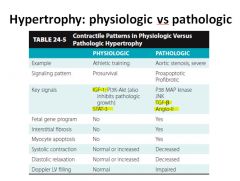
|
|
|
Molecular factors involved in cardiac hypertrophy:
|
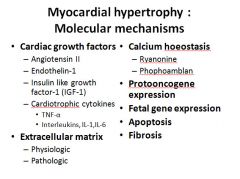
|
|
|
Concentric vs. Eccentric hypertrophy characteristics:
|
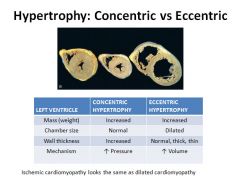
|
|
|
Pathologic hypertrophy can lead to fibrosis over time:
|

|
|
|
What are the 3 top causes of development of heart failure?
|
In order; Coronary artery disease, valvular disease and hypertension
|
|
|
Causes of systolic and diastolic heart failure diagram:
|
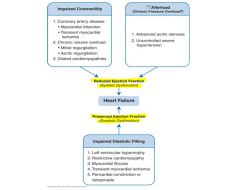
|
|
|
Differential diagnosis between systolic and diastolic heart failure:
|
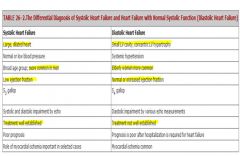
The small LV cavity and concentric LV hypertrophy will eventually end up being the large dilated heart with time.
|
|
|
What are two signs of end-stage HF?
|
Cheyne-stokes respirations (rapid breathing followed by a period of not breathing)
Pulsus alternans (alternating normal and depressed pulses) |
|
|
The pathophysiology of dyspnea:
|
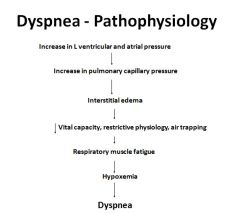
|
|
|
Pathophysiology of PND:
|
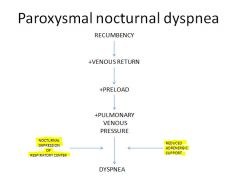
|
|
|
Pathophysiology of edema:
|
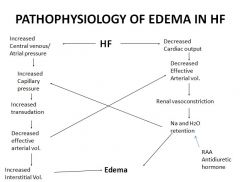
|
|
|
New York classes of Heart Failure:
|

|
|
|
Stages of CHF:
|
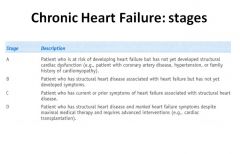
|
|
|
Kerley lines on chest X-ray in pulmonary edema:
|
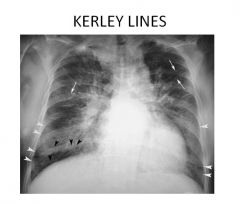
Kerley B lines = linear markings at the periphery of lungs that represent interlobular edema
Kerley A lines come from the periphery toward the mediastinum at an angle (engorgement of the lymphatics) |
|
|
Guidelines for therapy in systolic heart failure:
|
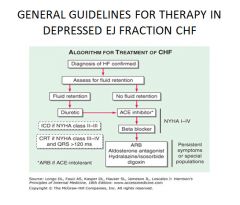
Loop diuretics are the most effective.
|
|
|
Treatment types according to manifestations of CHF:
|
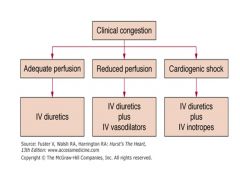
|
|
|
Causes of secondary pulmonary hypertension:
|
1) Chronic obstructive or interstitial lung disease, which is accompanied by destruction of lung parenchyma and consequent reduction in alveolar capillaries. This causes increased pulmonary arterial resistance and secondarily, elevated arterial pressure.
2) Recurrent pulmonary emboli, which lead to a reduction in the functional cross-sectional area of the pulmonary vascular bed, in turn, leading to increased vascular resistance. 3) Antecendent heart disease, for example, mitral valve stenosis, which increases LA pressure leading to higher pulmonary venous pressures and ultimately pulmonary arterial hypertension. * Congenital left to right shunts are another cause of secondary pulmonary hypertension |
|
|
Primary or idiopathic pulmonary hypertension:
|
The vast majority of cases are sporadic and only 6% have the familial form with an autosomal dominant mode of inheritance.
|
|
|
Pathogenesis of PH:
|
- Pulmonary endothelial cell and/or vascular smooth muscle dysfunction is the probable underlying basis.
- In secondary PH, endothelial dysfunction occurs due to the underlying disorder. Endothelial cell dysfunction reduces production of vasodilatory agents while increasing synthesis of vasocostrictors. In addition there is production of growth factors and cytokines that induce the migration and replication of vascular smooth muscle and elaboration of the extracellular matrix. - In primary PH, especially the familial form, the TGF-B signalling pathway mediates endothelial and SMC dysfunction. Germ line mutations of BMPR2 lead to loss of inhibition of proliferation of endothelial and SMC's. |
|
|
Clinical course of PH:
|
- Features of secondary PH: can develop at any age. Respiratory insuffinciency and right-sided heart strain.
- Primary PH: mostly in younger persons, common in women. Marked by fatigue, syncope, dyspnea upon exertion and sometimes chest pain. These persons usually develop severe respiratory insufficiency and cyanosis, and death usually results from right-sided heart failure in 2-5 years. |
|
|
Pulmonary hypertensive heart disease (cor pulmonale):
|
Cor pulmonale consists of right ventricular hypertrophy and dilation due to pulmonary hypertension caused by primary disorders of the lung parenchyma or pulmonary vasculature.
Cor pulmonale may be acute or chronic, depending on the tempo by which the pulmonary hypertension develops. Acute most commonly follows massive pulmonary embolism with obstruction of over 50% of the pulmonary vascular bed. Chronic occurs secondary to prolonged pressure overload caused by obstruction of the pulmonary vasculature, or compression or obliteration of septal capillaries (resulting from emphysema, interstitial pulmonary fibrosis, or primary pulmonary hypertension) |
|
|
Pathology of cor pulmonale:
|
- In acute, the RV is usually dilated but does not show hypertrophy; if an embolism causes sudden death the heart may be of normal size.
- Chronic is characterized by RV and often RA hypertrophy. In some cases the thickness of the RV wall may exceed that of the LV. When ventricular failure develops the RV and RA may also be dilated. * Because chronic occurs in the setting of chronically elevated pulmonary arterial pressure, the pulmonary arteries often contain atheromatous plaques and other lesions reflecting long standing pulmonary hypertension. |
|
|
When cardiac output increases, what keeps the resistance low in the lungs?
|
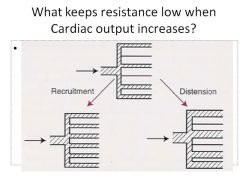
Recruitment of previously unused vessels and distenstion of vessels to handle an increase in flow.
|
|
|
What pulmonary pressures are required for a diagnosis of pulmonary hypertension?
|
> 25 mmHg at rest
> 30 mmHg at with exercise. |
|
|
How is pulmonary artery pressure measured?
|
Echocardiography with doppler
Right Heart catherization |
|
|
Diagram of normal pressure through the vasculature:
|
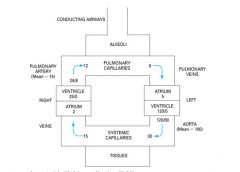
|
|
|
Pathobiology of primary pulmonary hypertension:
|
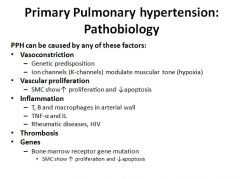
|
|
|
Two hit hypothesis in BMRP2 gene mutation:
|
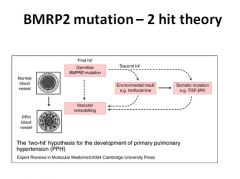
|
|
|
Histology of pulmonary hypertension:
|
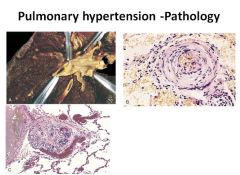
|
|
|
Gross appearance of heart in pulmonary hypertension:
|
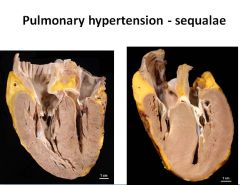
The heart on the left shows RV hypertrophy indicative of cor pulmonale
|
|
|
What is Eisenmenger's syndrome (ventricular septal defect)?
|
This refers to a condition in which an intraventricular left to right shunt results in such severe pulmonary hypertension that right-sided pressures eventually exceed systemic pressures, and the intracardiac shunt is reversed (becoming right to left).
|
|
|
What is pulmonary artery wedge pressure?
|
A catheter is inserted into the pulmonary artery until the tip occludes one of the branches. The pressure measured at that point in the vessel is equal to the pressure in the left atrium.
Normal value is about 8. But how does this relate to LV pressure? An increase in LA pressure usually means LV dysfunction. |
|
|
Pathophysiology of cor pulmonale:
|
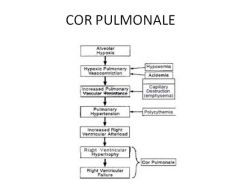
|
|
|
Physical exam signs of pulmonary hypertension:
|
Jugular venous distension
Triscupid regurgitation murmur Loud P2 Right sided S4 Pedal edema Ascites Para-sternal heave Cyanosis Digital clubbing |
|
|
Diagnostic tests for pulmonary hypertension:
|
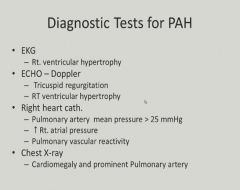
|
|
|
Flowchart for the workup of pulmonary hypertension:
|
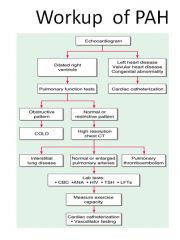
|
|
|
Degrees of severity of PH:
|
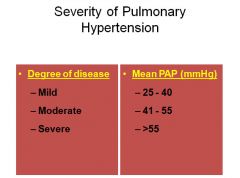
|
|
|
General treatment of pulmonary hypertension:
|
- Anti-coagulate with Coumadin
To prevent thrombosis - Calcium channel blockers in patients with responsive pulmonary vasculature - Diuretics and Digoxin for Right sided heart failure - Oxygen therapy |
|
|
Characteristics of left to right shunts:
|
- The most common type of congenital cardiac malformation
- Include atrial and ventricular septal defects and patent ductus arteriosus. - Cyanosis is not an early feature of these defects but can manifest after pulmonary hypertension has developed enought to produce right to left shunting (Eisenmenger syndrome). |
|
|
Atrial septal defects:
|
- ASD's initially cause left to right shunts, as a result of the lower pressures in the pulmonary circulation and right side of the heart.
- Defects are well tolerated if small in diameter. - With time, pulmonary vascular resistance can increase, resulting in pulmonary hypertension. |
|
|
Ventricular septal defects:
|
- The most common congenital cardiac anomaly at birth.
- Left to right shunt - Most close spontaneously in childhood. - Large defects cause a left to right shunt, often complicated by pulmonary hypertension and CHF. - PH with resultant reversal of the shunt and cyanosis occurs earlier and more frequently in patients with VSD than in those with ASD. |
|
|
Patent ductus arteriosus:
|
- Ductal closure is often delayed or absent in infants with hypoxia resulting from respiratory distress or heart disease.
- PDA's are high pressure left to right shunts, audible as harsh "machinery like" murmurs. |
|
|
Right to left shunts:
|
- Distinguished by cyanosis at or near the time of birth.
- Two important right to left shunts are tetrology of Fallot and transposition of the great vessels. - Clinical findings associated with severe, long standing cyanosis include clubbing of the fingertips and polycythemia. - Right to left shunts permit venous emboli to bypass the lungs and directly enter the systemic circulation. |
|
|
Tetrology of Fallot
|
The four features are:
1) VSD 2) Obstruction to the right ventricular outflow tracts 3) An aorta that overrides the VSD 4) Right ventricular hypertrophy - The hemodynamic consequences of TOF are right to left shunting, decreased pulmonary blood flow and increased aortic volumes. - The lungs are protected from hemodynamic overload by the pulmonary stenosis, so that PH does not develop. |
|
|
Transposition of the great arteries:
|
- The aorta arises from the RV and the pulmonary artery arises from the LV.
- Patients with a VSD tend to have a relatively stable shunt. - Patients with only a patent foramen ovale or PDA tend to have unstable shunts that need to be corrected in the first days of life. |
|
|
Aortic coarctation:
|
- Narrowing or constriction of the aorta; a form of obstructive congenital heart disease.
- Preductal coarctation with a PDA usually manifests immediately after birth. The delivery of poorly oxygenated blood through the DA produces cyanosis localized to the lower half of the body. - Postductal coarcation without a PDA is usually asymptomatic. Typically there is upper extremity hypertension, due to poor perfusion of the kidneys, but weak pulses and a lower blood pressure in the lower extremities. Adults tend to show exuberant collateral circulation around the coarctation involving markedly enlarged intercostal and internal mammery arteries. |
|
|
Types of abnormalities seen in congenital heart disease:
|
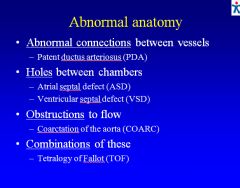
|
|
|
Normal circulation:
|
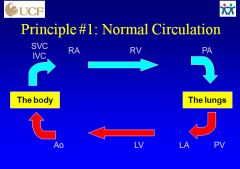
|
|
|
Normal oxygen saturation levels:
|
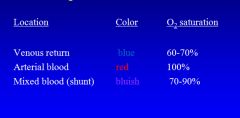
|
|
|
Diagram of a left to right shunt:
|
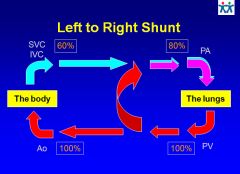
Making some parts of the blood volume get lost in this circular loop means the heart has to work harder because it gets more volume returned to it. More blood being put through the lungs means that lungs are subject to pulmonary overcirculation.
|
|
|
What is bad about a left to right shunt?
|
- HEART is subjected to excess blood volume
- LUNG is subjected to excess “overcirculation” -- this puts a strain on these organs *Pulmonary arteries are thinner, more compliant and have a thinner medial layer than other body artery types. They are more subject to damage occurring from overcirculation. |
|
|
Clinical manifestations of a left to right shunt part 1:
|
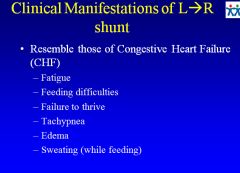
|
|
|
Clinical manifestations of left to right shunts part 2:
|
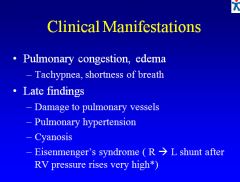
* Will start to see cyanosis in the patient at this point; is an irreversible condition with poor prognosis.
|
|
|
Patent ductus arteriosus:
|
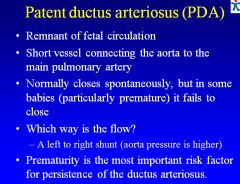
|
|
|
Consequences of a PDA:
|
Shunt direction?
- Left-to-right shunt O2 step-up/down? - O2 step-up in the pulmonary artery Effect on heart and lungs? - Heart: volume overload - Lungs: pulmonary overcirculation Clinical Manifestations? - Congestive heart failure - Pulmonary hypertension leading to Eisenmenger’s |
|
|
Consequences of an atrial septal defect:
|
Shunt direction?
- Left-to-right shunt O2 step-up/down? - O2 step-up in the right atrium Effect on heart and lungs? - Heart: Volume overload - Pulmonary overcirculation Clinical Manifestations: Pulmonary hypertension, Eisenmenger’s |
|
|
Consequences of a ventricular septal defect:
|
Shunt direction?
- Left-to-right shunt O2 step-up/down? - O2 step-up in the right ventricle Effect on heart and lungs? - Heart: Volume overload - Pulmonary overcirculation Clinical Manifestations: Congestive heart failure Pulmonary hypertension, Eisenmenger’s |
|
|
Therapy options to manage left to right shunts:
|
MEDICAL
Medicines to manage CHF (digoxin, diuretics, ACE inhibitors) SURGICAL Repair the anatomic defect, thus normalize the circulation |
|
|
Epidemiology of Congenital Heart Disease:
|
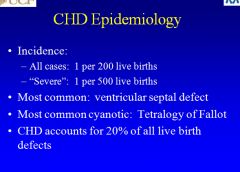
5% of CHD cases are associated with known chromosomal anomalies
|
|
|
Congenital heart disease in Down's syndrome:
|
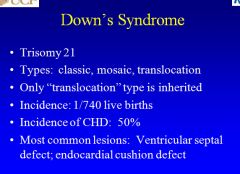
|
|
|
What's bad about a right to left shunt?
|
- Decreased oxygen in the blood (hypoxemia)
- Decreased oxygen delivery to tissues (hypoxia) - Increased hemoglobin (polycythemia) - Hypercoagulability, thrombosis |
|
|
Clinical manifestations of a right to left shunt:
|
Exercise intolerance
Cyanosis Cyanotic episodes, aka: “tet spells” Squatting Clubbing Stroke (due to hypercoagulability) Brain abscess (due to infective embolism) Premature death |
|
|
Diagram of tetrology of Fallot:
|

1) Narrowing of the pulmonary valve can lead to higher pressure in the right ventricle
2) Thickening of RV occurs secondary to higher pressure in RV. 3) Interesting, but not that important… 4) VSD is the most important |
|
|
The right to left shunt in tetrology of Fallot:
|
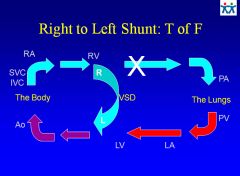
|
|
|
Consequences of TOF:
|
Shunt direction?
- Right-to-left shunt O2 step-up/down? - O2 step-down in the left ventricle Effect on heart and lungs? - Pulmonary blood flow decreased (due to obstruction) - RV hypertrophy |
|
|
Therapy for TOF:
|
Close the VSD
Relieve obstruction above, at and below the small pulmonary valve |
|
|
What is coarctation of the aorta?
|
A narrowing of the aorta just beyond the arch
|
|
|
Angiography images of coarctation of the aorta:
|
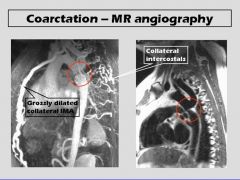
|
|
|
Diagram of coarctation blood flow:
|

All the processes of internal organs and muscle growth still occur due to development of collateral circulation.
Top half has high BP and is pink Bottom half has low BP and is blue |
|
|
Consequences of coarctation of the aorta:
|
- Ventricular hypertrophy leading to dysfunction
In long run: hypertension May persist after repair - “critical narrowing”: shock, ventricular failure, renal failure |
|
|
Overview of aneurysm locations and causes:
|
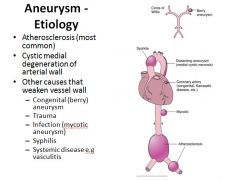
|
|
|
Cardiac aneurysms:
|
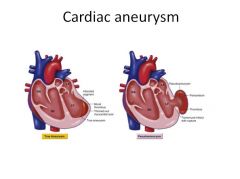
Cardiac aneurysms actually pouch outward while the rest of the myocardium contracts during systole.
These aren’t likely to rupture, but they do caused decreased function of the heart. |
|
|
Pathogenesis of an aneurysm:
|
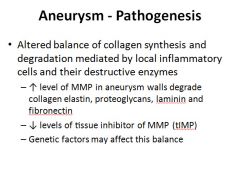
|
|

|
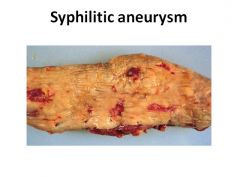
|
|
|
Rules for QT intervals:
|
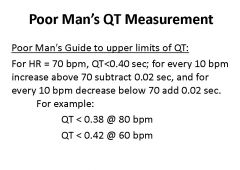
|
|
|
Review of the cause of Torsades de Pointes:
|
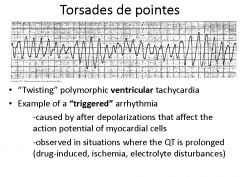
|
|
|
Example of prolonged QT:
|
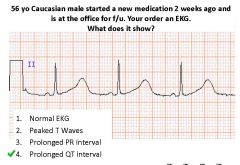
|
|
|
Example of WPW syndrome:
|

Recognizable because of the "delta wave" which is the slight upward slope on the QRS complex.
|
|
|
Example of AV nodal re-entrant tachycardia:
|
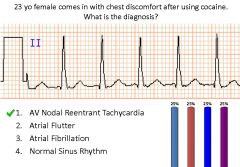
Recognized by a narrow QRS complex with a rate of 150-200 along with some P waves buried in QRS complexes.
|
|
|
Example of atrial fibrillation:
|
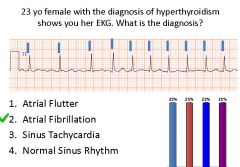
Recognized by very fast chaotic P waves with QRS complexes coming at different rates; ventricular rate irregular due to variable AV node block
|
|
|
Example of ventricular tachycardia:
|
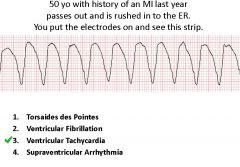
Characterized by wide QRS complex tachycardia. Can be regular or irregular.
|
|
|
Example of a STEMI:
|
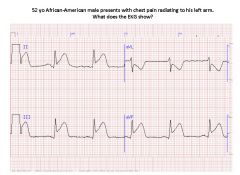
|
|
|
Correlation of lead abnormalities to damaged part of the heart:
|
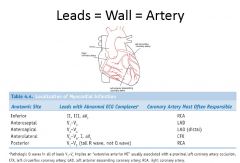
|
|
|
Example of 3rd Degree AV block:
|
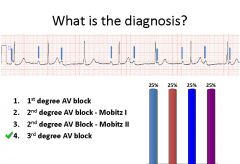
|
|
|
Example of 1st degree AV block:
|
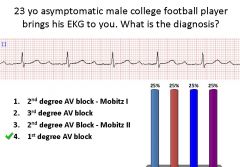
What do you tell your patient?
* No restrictions |
|
|
Cardiac Output in Ventricular Fibrillation:
|
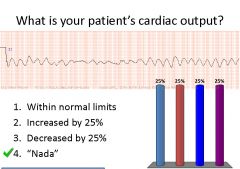
Best next step if this patient passed out on the street is chest compressions.
|
|
|
Another example of atrial fibrillation:
|
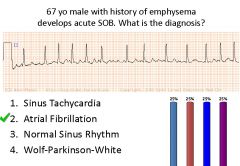
|
|
|
Example of atrial flutter:
|
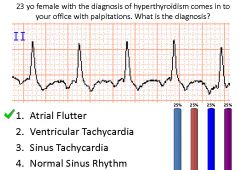
Re-entrant circuit localized to the RA.
Classic saw-tooth pattern |
|
|
Example of 2nd Degree AV block Mobitz Type I:
|

|
|
|
Example of Ischemia:
|

|
|
|
Example of sinus tachycardia:
|
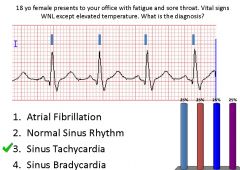
What would best explain the patient's HR?
* Fever |
|
|
Another example of atrial fibrillation:
|

|
|
|
Example of a 2nd Degree AV block Mobitz Type II
|
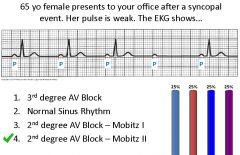
Randomly dropped QRS complex.
|

